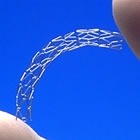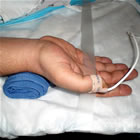
|
Hemostasis after IIb/IIIa infusions
|
|
||||||||||||
|
Current Postings on This Page (18): • Hemcon bandages are the best and not expensive.
Decreases hematomas and
turn around time. • Syvek Excel Hemostasis System is Excellent for
hemostasis management post IIb/IIIa's as well has Plavix, Aspirin and
all the other multi-modal drugs that
patients are now on, results have been great. • The syvek patch was invented by a biologist.
The money was from South America. The South American family The Finkelstines
of polish decent started
the company. • HemCon is a bandage that's being used on the battlefield in Iraq and Afghanistan. Some research has been done in porcine models to test its usefulness for femoral artery puncture hemostasis, but to our knowledge it is not currently an appproved product for this use. You can read more about it on HemCon's company web site. We would also point readers to our new
section on "Radial Access" and specifically to our interview
with Dr. R. Lee Jobe in
which he discusses the fact that his center uses the radial approach, if
possible, specifically when they receive emergency patients who have been
aggressively
anticoagulated with heparin and a IIb/IIIa inhibitor. • Has anyone heard of the new product called HemCon
for hemostasis? • Simpler is better. For those using finger pressure
please consider the FAVC-HandHeld to improve your comfort. It has the
best of both worlds, hand held and able to adjust local pressure as needed
when
needed. Additionally, it's 2.2 pounds so it takes the strain off your
hold and because it uses a disposable disc it helps with blood born pathogen
control. interventionalhp.com • A great cost saver that works just as efficiently
is TZ Medicals Neptune Pad. Its a topical hemostasis pad that is used in
cardiac cath labs, radiology and dialysis departments for radial, brachial
and hemodialysis procedures. Very similar to Syvek but in most cases costs
30% less. A study was done at Cleveland Regional Medical Center that compared
Syvek, Chito-seal, D-stat and Neptune and all products had similar results.
Hold times consistently stayed around 6-10 minutes, but I would stay with
hospital protocol. • Syvek is not a placebo. There was a double-blinded
randomized study with Syvek versus a placebo patch. Syvek decreased the
time to hemostasis by 37% with decreased complication rates. • I feel C-clamps could be dangerous if left on
a pt without consistent supervisior which is often the case if left on
for an hour, also complete bedrest usually last 6-12 hours depending on
the Dr. femstops tend to bruise and is also like the clamp very uncomfortable
for the patient. I like manual pressure, syvek patch, D-stat, perclose
and the angioseals • I am looking to make contact with cathlab practitioners
who has had experience with using topical devices like Syvek, CloSur in
their labs. Please contact me. • No. • Syvek patches are great. My techs love them and
have had phenomenal success with them. We do about 600+ angios per year
and use Syvek in about 95%. We even use them after a perclose or angioseal
fail! • We have a <1% hematoma rate ever since the inception
of using the Syvek patch. We also use the SyvekNT patch on interventional
patients while increasing the hold from 10 minutes to 20 minutes with the
same hematoma outcomes. We have been using Syvek for approx 2 years. Some
say that the Syvek patch is a placebo. I pull the sheaths, and I'm a firm
believer in the product and do not see a placebo effect. I would love to
see some data on studies stating that the syvek is a placebo. I just don't
see it at all. The patch is remarkable, and I'd work for the company and
sell the product if I could! • Syvek patch? I presented a paper at SCAI. Another
poster was about Syvek patch and how they are no better than placebo. What
do really have for proof besides anecdotal experience? Need more data to
continue a $50 patch vs. 10 minutes of fingers. • I would like information on the best closure
device post PTCA. We usually manage these patients with manual compression
x thirty minutes but are looking into closure devices. I am interested
in information on syvek patch, angioseal, & compress ar. We have femostop
available and have not used it in > 1year. • If you have the benefit of current vascular closure
devices (angioseal, perclose, vasoseal, or the syvek patch) no compressor
clamps or femstops are routinely needed. The syvek patch is the only device
which is actually approved for post interventional patients however as
long as ACT is not much over 300 we routinely use all these devices. We
are a 2 lab facility which did approx. 1000 interventions last year and
had minimal complications when pulling sheaths on the table and patients
recieving 2b3a. • Absolutely not, I currently manage a cardiac Intevention
Unit at Providence Hospital in Mobile Al. We see about 800 post Intervention
patients with most on IIB-IIIA Platelet Inhibitors. We use Compressar Clamps.
After the Sheath is removed we keep the patient on the clamp for about
1 hour. We keep the patients on complete bedrest until after the IIb-IIIA
platelet inhibitors have been stopped. We only use Femostops when complications
occur. Our complication rate is <1%. We been open for 2 years. • How are you managing hemostasis after interventions
when patients are receiving IIb/IIIa infusions? Is this an automatic indication
to use the Femostop device? |
|||||||||||||






